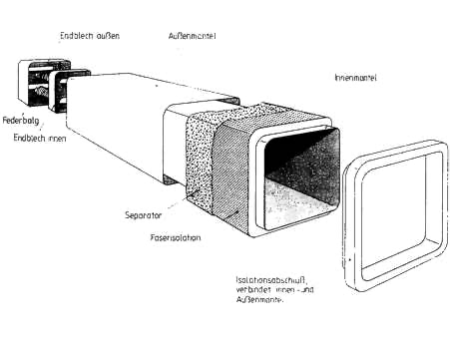GVI Properties and design possibilities
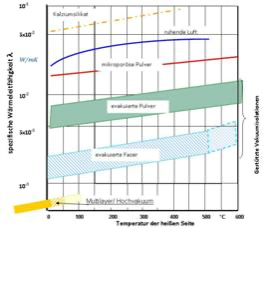
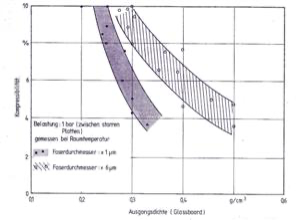
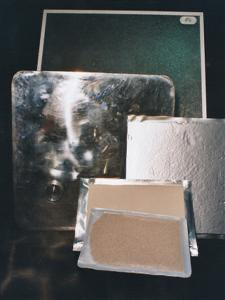
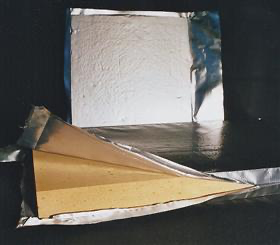
The outstanding properties of the GVI® systems (Supported vacuum insulation systems)
The properties of different systems essentially depend on the materials used (both shell material and filler). In this way, “tailor-made” solutions can usually be found for the respective task. Some rough guide values for individual properties are listed below.
Application temperatures
In general, GVI® systems can be safely controlled for temperatures from absolute zero (see www.kryo-safe.de) up to temperatures of 500° to 600°C – for special applications, combustion chambers up to 1000°C application limit temperature have already been built by TEB – Here, however, special attention must be paid to the permeation behavior of the shell materials used (if necessary, a cyclic post-evacuation must be provided for).
The standard VIPs (vacuum insulation panels) available today (shell material: PE foil; core material: pyrogenic silica – see below) can be used in a temperature range of approx. -40°C to +70°C due to the shell materials used.
Insulating properties
The insulation properties of a ready-to-install GVI® system depend on the filling material as well as on the geometry/construction and the cladding materials used. Depending on the system, the enveloping material always forms a connection somewhere between the warm and the cold side of the component. Because of the increased solid-state heat conduction, these thermal bridges should be carefully considered and designed to properly minimize overall heat loss.
The heat losses via the (undisturbed) vacuum-insulated surfaces depend on the filling material used. In analogy to the general explanations (see above), there is a fundamental connection between microporosity, residual gas pressure and solids content. The finer the pores of the filler, the higher the permissible residual gas pressure. In the case of coarsely porous materials, the cell walls are often thicker. With the appropriate material properties (specific thermal conductivity), the overall heat conduction of the system is also higher. The table in the “Materials” section lists some of the specific thermal conductivities of different GVI® systems that can be achieved today.
The following image shows the thermal conductivity as a function of the residual gas pressure for two different fillers (nanoporous powder and microporous glass fiber board). The values were determined for a mean temperature of 350°C.

GVI® insulation for changing temperatures
With conventional insulation, the dew point often falls below the dew point within the insulating layer during operation with changing temperatures – and as a result, moisture penetration and rotting of the insulation. Such effects cannot occur with GVI® systems because the insulation is hermetically encapsulated. For the same reason, no operating materials or harmful gases from the process to be insulated can penetrate into the insulation.
Mechanical properties of GVI® systems
When designed accordingly, supported vacuum insulation has very high compressive strength and rigidity – comparable to a honeycomb sandwich element. This effect can be influenced by the choice of the shell material thickness and the entire construction. The compressive strength also depends on the particular properties of the core material.
Vibration resistance
There is a lot of experience from applications in the automotive sector. Such insulating housings are exposed to strong vibration and shaking loads, which the filling material must primarily withstand – with the appropriate design, this is easily possible. The fiber boards we use meet all the requirements compared to the powders (fumed silica) used in classic VIPs – especially when high forces have to be absorbed at the same time).
Material selection
a) Shell materials
We use metallic shell materials as standard for GVI® systems. Due to the relatively low specific thermal conductivity, high strength and good weldability, austenitic stainless steels offer particular advantages. Other materials, such as the light metals aluminum or magnesium, offer advantages above all for extremely lightweight applications.
For lower temperature loads, organic (lightweight) materials are also often used: Large-area containers can be made of glass fiber reinforced plastics (GRP) – in our experience, such housings are sufficiently vacuum-tight if the matrix resin is properly selected.
b) Filling materials
As a rule, these are mineral materials with the lowest possible solid-state thermal conductivity, very low outgassing, sufficient support and, last but not least, a fine-pored structure – to ensure good evacuation, the pores must be open!
Depending on the form of application, prefabricated molded parts (e.g. plates, pipe segments, etc.) or free-flowing materials can be inserted into the double-walled insulating cover.
Filling materials GVI®
| silicate foam | glas-bubbles | fibre board | |
| application form | free-flowing granules | free-flowing powder | high-strength panels and molded parts |
| insulating capacity (at 300°C) | good < 8 mW/mK | very good < 4 mW/mK | very good < 3mW/mK |
| required residual gas pressure | < 0,1 mbar | < 0,1 mbar | < 0,1 mbar |
| evacuation capability | very good | very good | very good |
| compressive strength | good | good | very good |
| recycling capability | very good | very good | very good |
| costs | very low | very low | low |
Design possibilities
Two different designs are known for supported vacuum insulation:
a) VIP (vacuum insulated panel)
VIPs are prefabricated flat elements that can be used today to insulate e.g. refrigerators or entire house fronts. The vacuum-tight shell of these components consists of multi-layer PE foils with an aluminum coating. Possible limit temperatures (see also the Materials section) are limited and the VIPs must be protected against damage.
Commonly used with other cladding materials (e.g. stainless steel) especially for very large-area components and extreme temperatures (see the following image: cryo-cabin composed of individual surface elements).
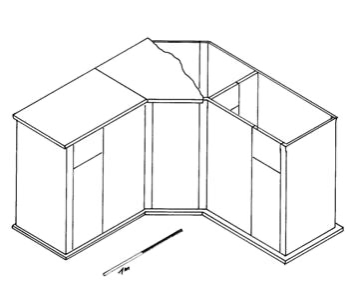
b) VIC
VIC are vacuum-insulated cabinets – i.e. more or less completely enclosing, double-walled containers. Compared to an insulation composed of VIP, the insulating properties are significantly better because the numerous thermal bridges at the joints of the individual elements are eliminated. In addition, VIC are significantly more resistant to any form of mechanical stress! Almost any geometry can be created with such housings.
The structure of a VIC is shown in the sketch below
